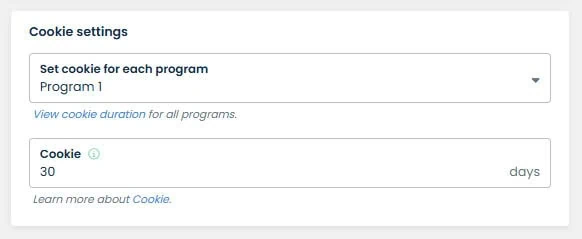As a matter of fact, 8 out of 10 brands (80%) run affiliate campaigns to enhance their brand awareness and drive revenue higher (Rakuten). So, staying ahead in this game is truly challenging.
To stand out in this competitive landscape, it’s essential to understand what other businesses in your niche are doing with affiliate marketing, running their campaigns through affiliate marketing software or networks, and then develop your own smart strategies. Beginning with an affiliate competitor analysis will give you valuable insights on how to make your program more attractive.
It’s alright if you don’t know where to start!
In this article, we’ll explore what affiliate competitor analysis is and why it matters to your business. We’ve also put together a guide highlighting 4 steps to effectively research your competitors and how to leverage this analysis to strengthen your affiliate campaign.
Our step-by-step guide to affiliate program competitor analysis:
Step 1: Identify your primary competitors
Step 2: Find and study competitors’ affiliate programs
Step 3: Analyze competitors’ affiliate programs
Step 4: Conduct a SWOT analysis of competitors’ affiliate programs
Do you want to build, run, and optimize your own affiliate program yourself to outperform those of your rivals’? Check out UpPromote, the top-recommended affiliate marketing app on Shopify, trusted by experts and over 115,000 users worldwide to start.
UpPromote surpasses competitors as the #1 Shopify affiliate app, providing a game-changing solution to keep you ahead in affiliate marketing.
What is Affiliate Competitor Analysis?
Affiliate competitor analysis is basically the process of discovering, analyzing, and gaining insights into the affiliate programs run by your direct competitors.
Performing thorough research on how your rivals approach affiliate marketing isn’t about copying their tactics. Rather, this is done with the aim of learning from them and finding opportunities to differentiate yourself.
Why Should Your Brand Do Affiliate Competitor Analysis?
Understanding your competitors is not just beneficial—it’s essential in the highly competitive landscape of affiliate marketing.
Carrying out a comprehensive affiliate competitor analysis when starting your own campaign will enable you to:
- Benchmark how your program stacks up against industry standards and other brands within your niche. Then, adjust commission rates, cookie durations, and payment terms.
- Gauge competitors’ strengths and weaknesses. Use this information to strengthen your program’s distinctiveness and capitalize on opportunities where they fall short.
- Choosing the right affiliate types and learning effective retention strategies by observing how your rivals are pulling them off.
- Keep your brand up-to-date on affiliate marketing. This includes new tools, tactics, and shifts in consumer behavior. By keeping your brand up-to-date on these changes, you can quickly adapt to stay relevant and competitive.
How to do Affiliate Program Competitor Analysis: A-Step-by-Step Guide
Researching the affiliate programs of your rivals is not easy at all. You’ll also need a strategic approach so that you do not miss any key points regarding affiliate competitor research.
Here’s a step-by-step guide to help you sail through the process:
Step 1: Identify Your Primary Competitors
To start, you need to know who you’re up against in your field.
Generally speaking, competitors are other businesses that offer similar or very close products/services as yours to the same kind of customer.
So, how can you quickly identify them and create a list for further exploration?
Begin with keyword research. The main purpose is to find competitors who are targeting the same keywords and phrases relevant to your business.
Following are a few ways through which you could do this efficiently:
Conduct a Google search
Use keyword-related search on the most popular search engine, Google. This is probably the most no-brainer way to figure out key players offering similar products or services. Try searching with phrases like:
- Top [your niche] brands
- Best [your niche] companies
For more specific results, you can add terms about your country or region to narrow down the search.
For example, if you are selling organic skin care products in the US market and want an idea about businesses offering the same products operating therein. Some of the keywords that you can use to find out about them are:
- Top 10 organic skincare brands in the US
- Certified organic skincare brands in the US
- Best organic skincare brands in the US
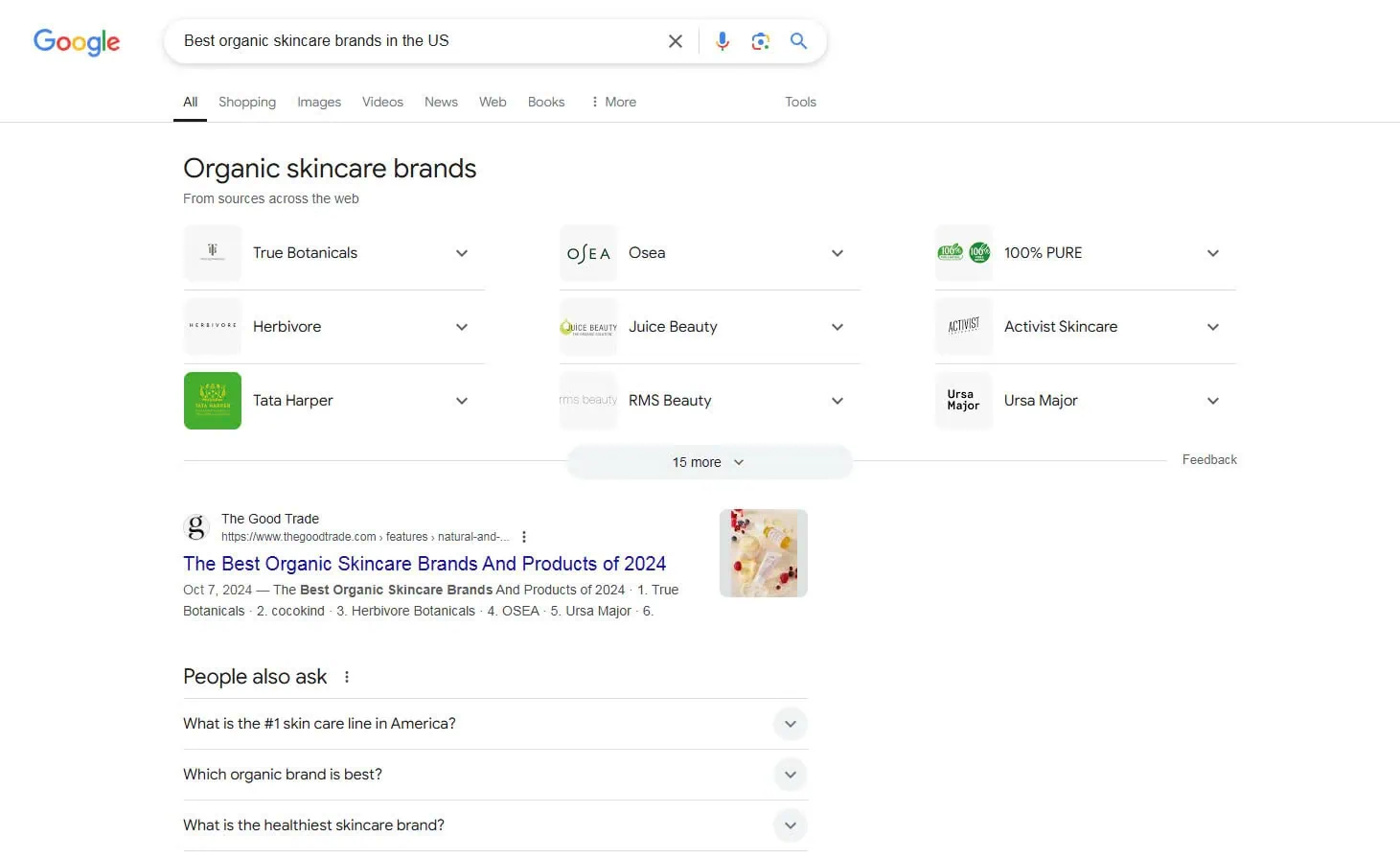
You should analyze the results to find out your rivals. Pay attention to:
- Featured snippets and knowledge panels: Quick answers or summaries that Google displays at the top of search results.
- Top search positions: Focus on brands that rank on the first page of search results for your main keywords.
- Paid ads: Companies pay for ads on these keywords, indicating they are actively targeting your audience.
Browse through social media
Other useful resources to find your competitors include social media sites like Facebook, Instagram, TikTok, and X. Use each platform’s search feature to find industry keywords and trending niche hashtags.
Let’s continue with an example as if you’re the owner of an organic beauty skincare store. You might enter the keyword “organic skincare” or the hashtag #Organicskincare on Instagram. The platform will then display various accounts of other brands in the same field, as shown below:
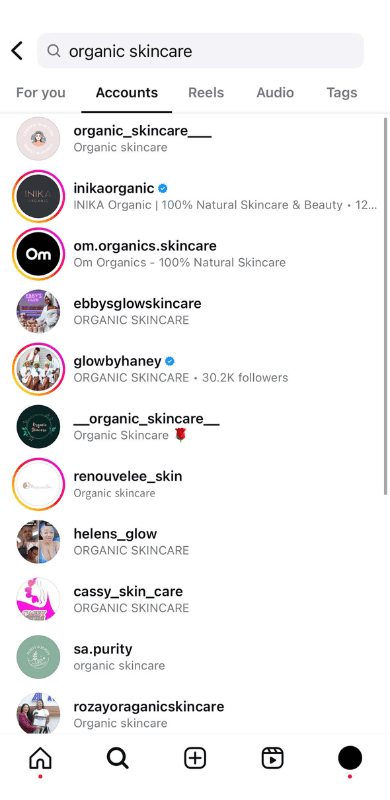
If you click on one of these accounts, Instagram’s algorithm will automatically suggest more beauty and health companies for you to check out like this:
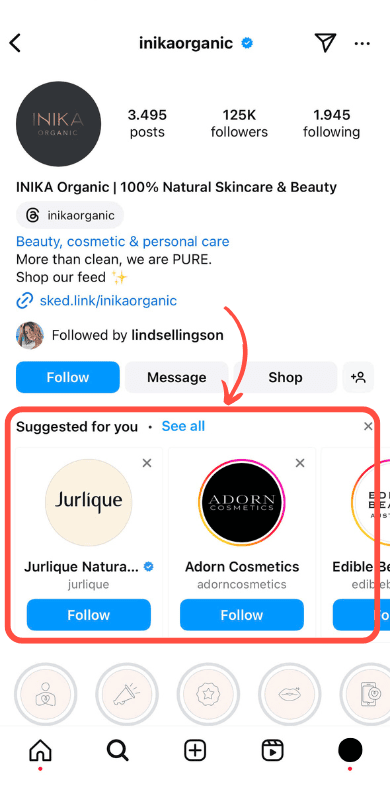
When viewing these accounts, focus on the following:
- Prioritize those brands with a high number of followers. This metric often indicates their influence within your industry.
- Check likes, comments, and shares on their posts. Accounts with high engagement are strong competitors, as they attract customer attention.
- Read customer comments on their products or services. This feedback helps you understand their reputation and customer satisfaction levels. Brands with a high volume of positive reviews are worth noting.
💡 Actionable tips:
From your search, compile a list of 5-10 key competitors based on their reputation in your niche, their positions in the search results, their follower count, and their engagement rate.
Step 2: Find and Study Competitors’ Affiliate Programs
You might be wondering: What’s next?
Once you’ve identified direct rivals in your niche, it’s time to gather information on their affiliate programs. This lets you see what tactics they are applying and uncover elements that could strengthen your own campaign.
Here’s what you can do:
Review Their Affiliate Landing Pages in Detail
Follow your list of top competitors to visit their websites and locate their affiliate program landing pages.
Most brands include an affiliate program page in the website’s footer or header. While browsing these sites, you might see terms like “Affiliate Program,” “Affiliates,” “Affiliate Sign Up,” or “Partnership” in their footers or headers.
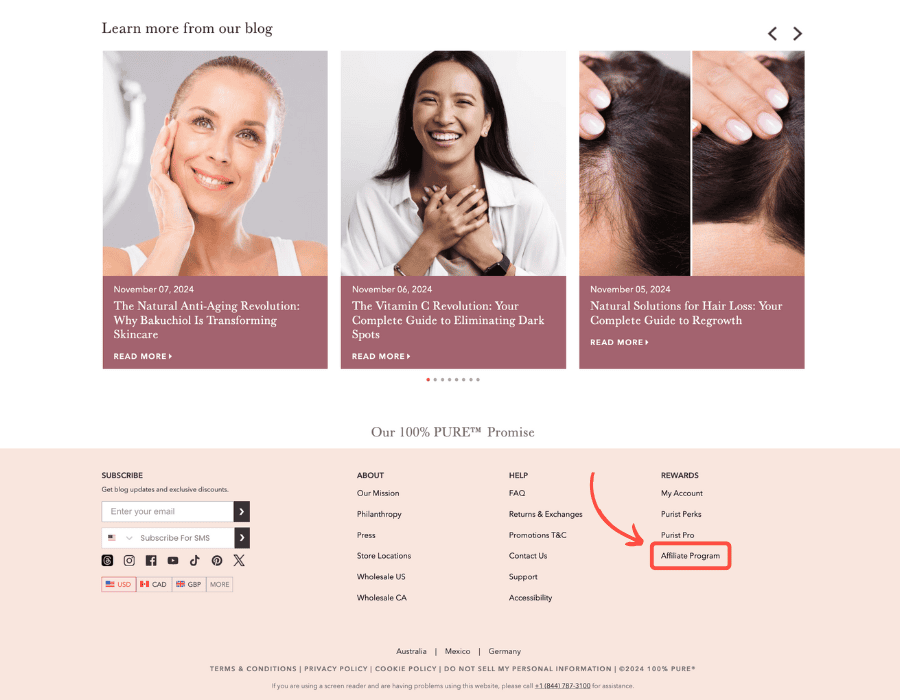
If you can’t find a link to their affiliate page, try Googling “[Competitor business name] + affiliate program” for more information.
Typically, businesses create affiliate signup pages to attract potential affiliate marketers. These landing pages often showcase key benefits of their affiliate programs, such as commission rates, tracking methods, and payment frequency.
Exploring competitors’ affiliate program pages not only provides an overview of how they position their campaigns and what makes them appealing but also offers ideas for designing your own affiliate signup page to capture affiliates’ attention effectively.
Join Your Rival’s Affiliate Program
Yes, you’ve browsed through your rivals’ affiliate landing pages. However, this is just the tip of the iceberg. What you see on their affiliate landing pages is only a highlight of their offers.
To gain real insights into a competitor’s program, one of the best strategies is to join it. This way, you can see it from the perspective of an affiliate.
There are 2 ways to apply for the rivals’ affiliate program:
- Submit an application form directly on their affiliate signup page.
- Join an affiliate network that your competitor partners with to enroll.
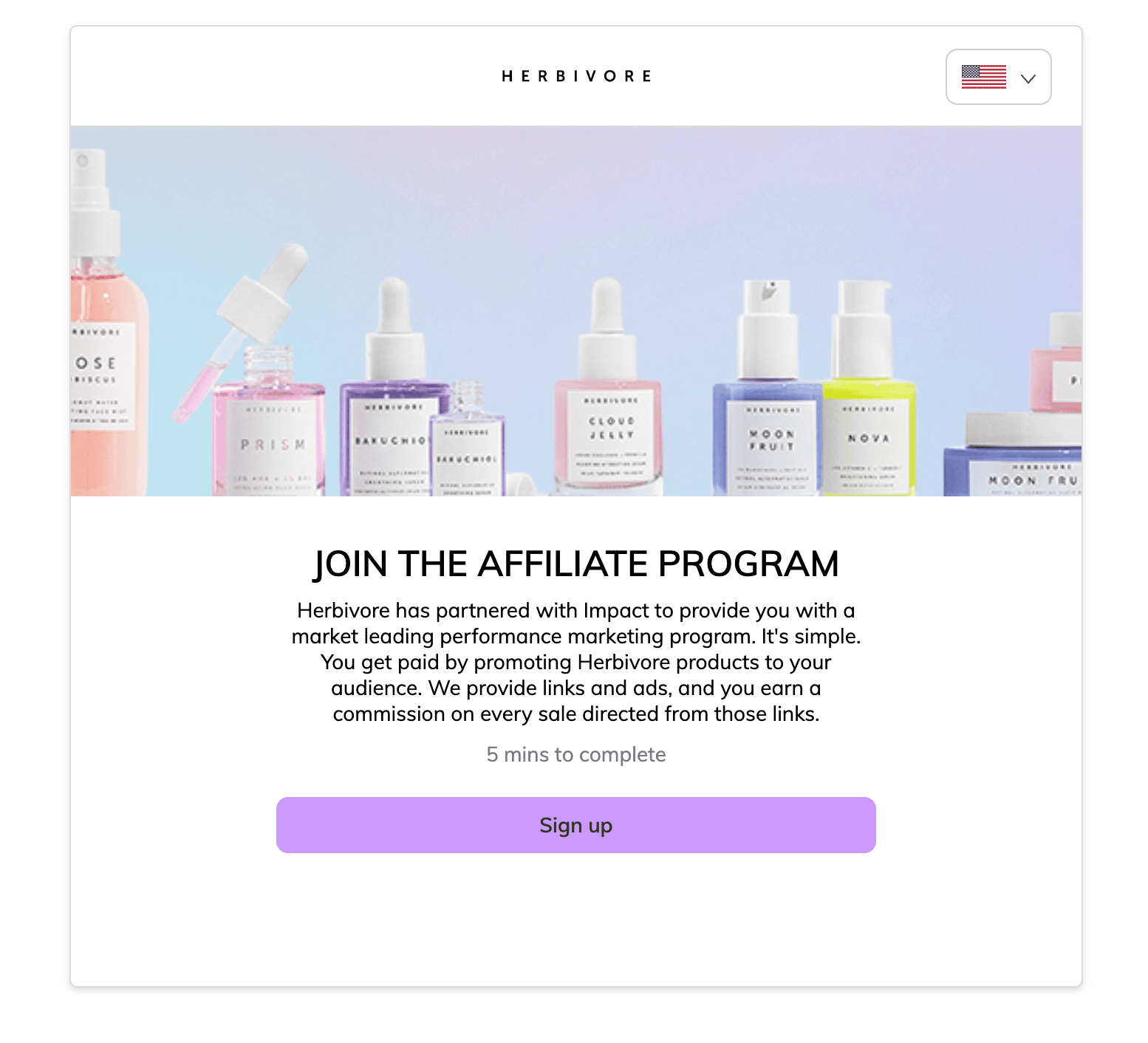
After joining, you’ll be able to uncover valuable information, such as:
- Affiliate signup experience
- Affiliate agreement
- Partner onboarding process
- Tools and resources provided to affiliates
- Strategies used to support and engage partners
- Incentives to motivate affiliates
Remember to note down all important details for later comparison.
Step 3: Analyze Competitors’ Affiliate Programs
Just listing down information about competitors’ affiliate programs is not enough. You should scrutinize and analyze their campaigns in detail to uncover their affiliate marketing strategies.
Here are the key components to keep in mind:
Program Accessibility
How easy it is to join an affiliate program can leave a big impression on potential partners. Trying to join your competitors’ programs yourself helps you understand the process better.
Here’s what you can assess based on your own experience:
- Is the affiliate program open for anyone to apply, or does it have specific requirements for candidates?
- Is the sign-up process quick and straightforward? Do affiliates need to create accounts on an affiliate network to get access?
- Are the program’s terms and conditions easy to understand?
- Does the brand conduct extensive screening of applicants? How long does it take for an application to be approved?
A thorough evaluation will reveal if they make it easy for affiliates to join and how they control the quality of new participants.
Commission Structures
Let’s be real: affiliates join any campaigns mainly to make money. A good commission structure is what draws them in and keeps them around.
Look at your competitors to see what types of commissions they’re offering and how much they’re willing to pay their partners. Are they setting the affiliate commission in the form of:
- Percent of sale: Affiliates earn a percentage of their total sales, e.g., 15% of the total order amount.
- Flat rate per item: Affiliates get a set amount for each product sold, e.g., $15 per item.
- Flat rate per order: Affiliates receive a fixed amount for each referral order, e.g., $15 per order.
- Tiered commission: Affiliates earn more as they hit higher sales targets. For instance, they get 10% for sales under $300 and 15% for sales over $300.
That said, commission rates can differ between brands. To get a clear picture, check out the average in your niche. Then, compare it to what your competitors provide to see how they’re positioning their programs—are they paying more or less than the typical rate?
To research the standard commission rate within your industry, you can try:
- Look for industry reports on affiliate marketing trends or commissions. Some reliable resources include AffStat, AM Navigator, or CJ Affiliate.
- Join affiliate marketing groups on Facebook, LinkedIn, or Quora. Browse threads or join discussions to learn about typical commission rates in your field.
- Check affiliate networks or marketplaces like ShareASale, Rakuten, or UpPromote’s Marketplace. See if your product category has a common range.
Some popular product categories and their associated affiliate rates you might come across are:
- Beauty & Personal care: 5%–20%
- Fashion: 5%–20%
- Electronics & Gadgets: 2%–8%
- Food & Drink: 10%–20%
- Pets: 10%–20%
Cookies Duration
Affiliate cookie duration is how long a tracking cookie stays on a user’s device after they click an affiliate link. It sets the time frame in which an affiliate can earn a commission for bringing in a customer.
Some common cookie durations with affiliate marketing you can counter are:
- Short-term cookies (24 hours to 7 days)
- Medium-term cookies (15 to 30 days)
- Long-term cookies (60 to 90 days or more)
For example, Nike’s affiliate program has a 7-day cookie period. That might feel a bit short.
This means that if an affiliate joins Nike’s program and a customer clicks their affiliate link but doesn’t make a purchase right away, the sale will still count for the affiliate as long as the customer returns and completes the purchase within 7 days.
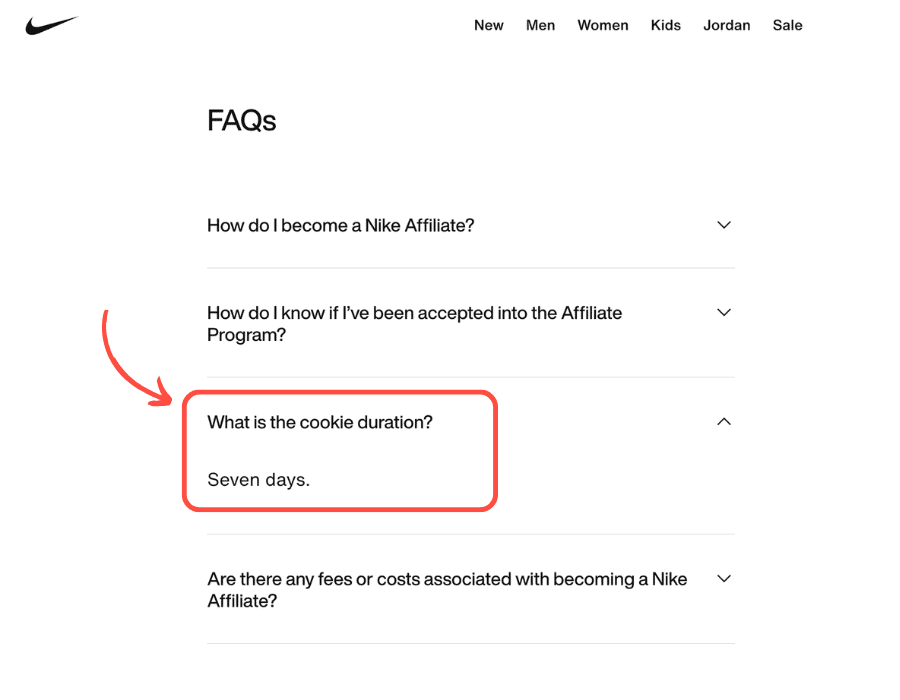
Most affiliates actually like longer cookie durations. It gives them a better chance to earn commissions if the customer needs more time to decide. This can be a key factor when choosing between similar programs.
So, don’t overlook finding out the average cookie duration that most of your rivals choose. Check whether they opt for a short or long cookie period, and then compare it to your own.
Payment Terms
Another thing to look at is how your competitors set up payment terms for their affiliates. Clear and fair payment terms can go a long way in boosting partner satisfaction and loyalty.
Some key things to keep an eye on are:
- Determine whether they offer monthly, bi-weekly, weekly, or on-demand payouts. On-demand payouts let affiliates request payment once they hit a minimum threshold.
- Do other brands in your niche use checks, or do they prefer faster options like PayPal, bank transfers, or digital wallets? Do they offer one or multiple payout methods?
- Assess whether most of your competitors set minimum payout thresholds. Are these thresholds reasonable and achievable for their affiliates?
- Check if your competitors clearly state payment details in their affiliate terms or during the onboarding process.
Affiliate Recruitment Methods
Understanding how competitors recruit affiliates can reveal effective strategies and channels for expanding your own affiliate network. Take the time to dig deeper and analyze their approach.
Of course, each brand has its own tactics for finding and attracting affiliates. Ask yourself questions to enhance your detailed analysis: Do any of your competitors rely on just one channel or way to recruit affiliates? If not, what methods are they using?
Based on these questions, try the following ideas to dig deeper into how they attract affiliates to their program:
- Look at affiliate networks, especially any linked to their signup page, to see if their offer is listed there.
- Check their social media accounts to find out if they’re promoting the program. You can use simple keywords like “join our affiliate program” or “affiliate partners wanted” on their page to spot relevant posts.
- If you’re part of any affiliate marketing groups or forums, search for any mentions of their program.
Finding this info will be so helpful for understanding which platforms they use to promote their affiliate program and how they create content, images, or videos to showcase it.
Should you try signing up for their affiliate programs, don’t forget to watch out for these details:
- If they provide a welcome message when an affiliate is approved.
- Any guides or tutorials offered to help new members get started.
- Availability of support during the setup process for newcomers.
Types of Affiliate Partners
Each industry has unique audiences, products, and sales cycles. So, choosing the right affiliates is key to any brand’s affiliate marketing plan. This is true for your competitors, too. By checking out the types of affiliates they partner with, you can get ideas for who might be a good fit for your brand.
You may be wondering: Which types of affiliates do your competitors favor? Are they bloggers, social media influencers, coupon sites, or review sites?
To dig deeper, try these steps to find your competitors’ affiliate publishers:
- Use tools like SimilarWeb or Ahrefs to see which sites send traffic to your competitors, identifying affiliate websites linking to them.
- Explore competitors’ social media accounts to see if they’ve shared posts from influencers or mentioned them. These individuals are likely affiliates.
- Search hashtags related to your competitors’ brand names on social media.
- Track mentions of your competitors using tools like BuzzSumo or Mention to see who’s promoting their products.
After identifying the types of affiliates your competitors are working with, you can summarize the key insights as follows:
- Which specific types of affiliates do most of your rivals opt for?
- What are these affiliates’ main traits—strong online presence, good reputation, high engagement, or else?
- How does each type promote your competitors’ products?
Then, compile all this information into your ideal affiliate profiles and identify the types of affiliates you should prioritize for outreach.
Affiliate Tracking App or Networks
While studying other brands’ affiliate programs, pay attention to how they run their affiliate campaigns.
Which approach have your competitors chosen between the 2 options below:
- Managing an in-house affiliate program
- Partnering with an affiliate network
Run an in-house affiliate program
This means a brand manages its own affiliate program independently. This company handles everything—finding affiliates, measuring affiliate results, making payments, and staying in touch with partners.
In such a case, the brand usually installs affiliate marketing software with the store’s website to build, manage and track its affiliate campaign independently.
For instance, if your rival opens an online store on Shopify, the brand could use an affiliate tracking app like UpPromote.
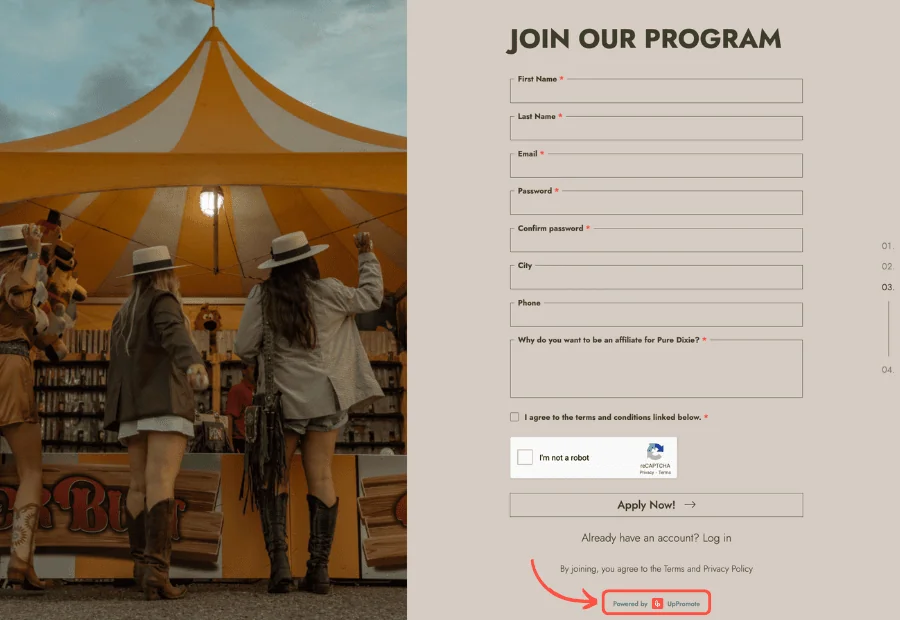
Use an affiliate network
This approach involves partnering with a third-party platform. It connects brands with a large pool of affiliates.
The network handles many aspects of the affiliate program, such as tracking referrals, managing payouts, and providing access to affiliate recruitment.
Rakuten, Awin, CJ Affiliate, and Impact are just a couple of examples.
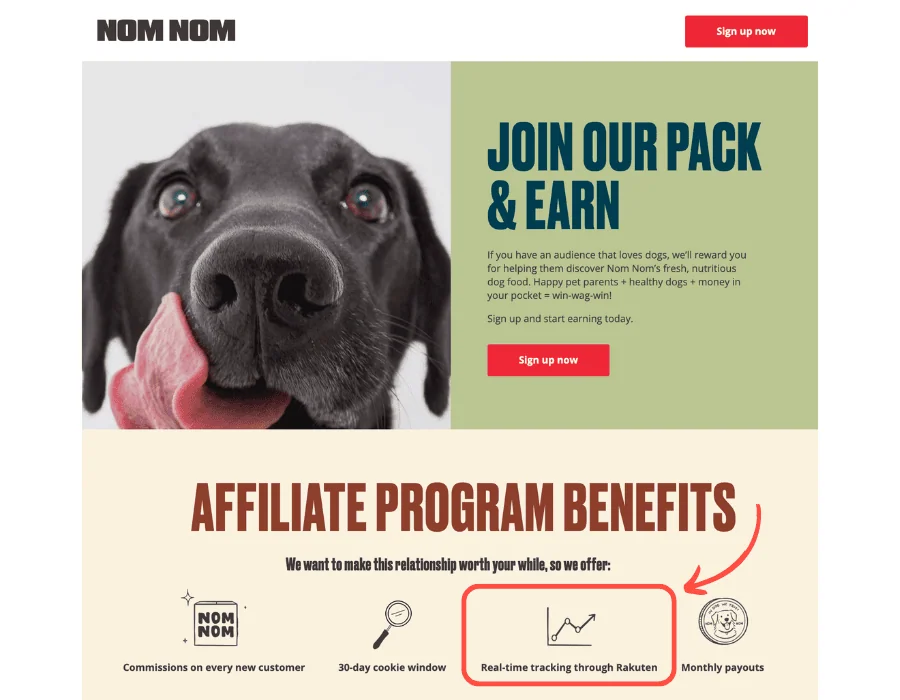
Noticing whether your competitors use affiliate tracking software or rely on affiliate networks to manage their programs can prompt you to explore why they choose one over the other. From there, you can select a solution that best fits your brand’s needs.
Affiliates Motivation
In your analysis of competitors’ affiliate programs, take note of the methods they use to keep partners motivated and engaged.
Here’s what to examine:
- Do they care about building a sense of community among affiliates? Perhaps by creating a social media group, a forum, or hosting webinars?
- What kind of support do they offer affiliates? For example, do they give their partners access to marketing materials, tutorials, or exclusive deals and promotions to help them promote products more effectively?
- How do they celebrate affiliates’ sales milestones? Consider the incentives they provide. Are they cash, gift packages, store credit, or something else?
- Do they run affiliate competitions to boost performance? If so, which contest formats do they choose? Social media engagement, most sales, content creation, or seasonal affiliate contests?
Take CrakRevenue, a well-known CPA (Cost Per Action) network, as an example. The brand often conducts ranking-based sales contests to encourage its partners. Besides cash prizes, CrakRevenue also offers exclusive gifts to top achievers.
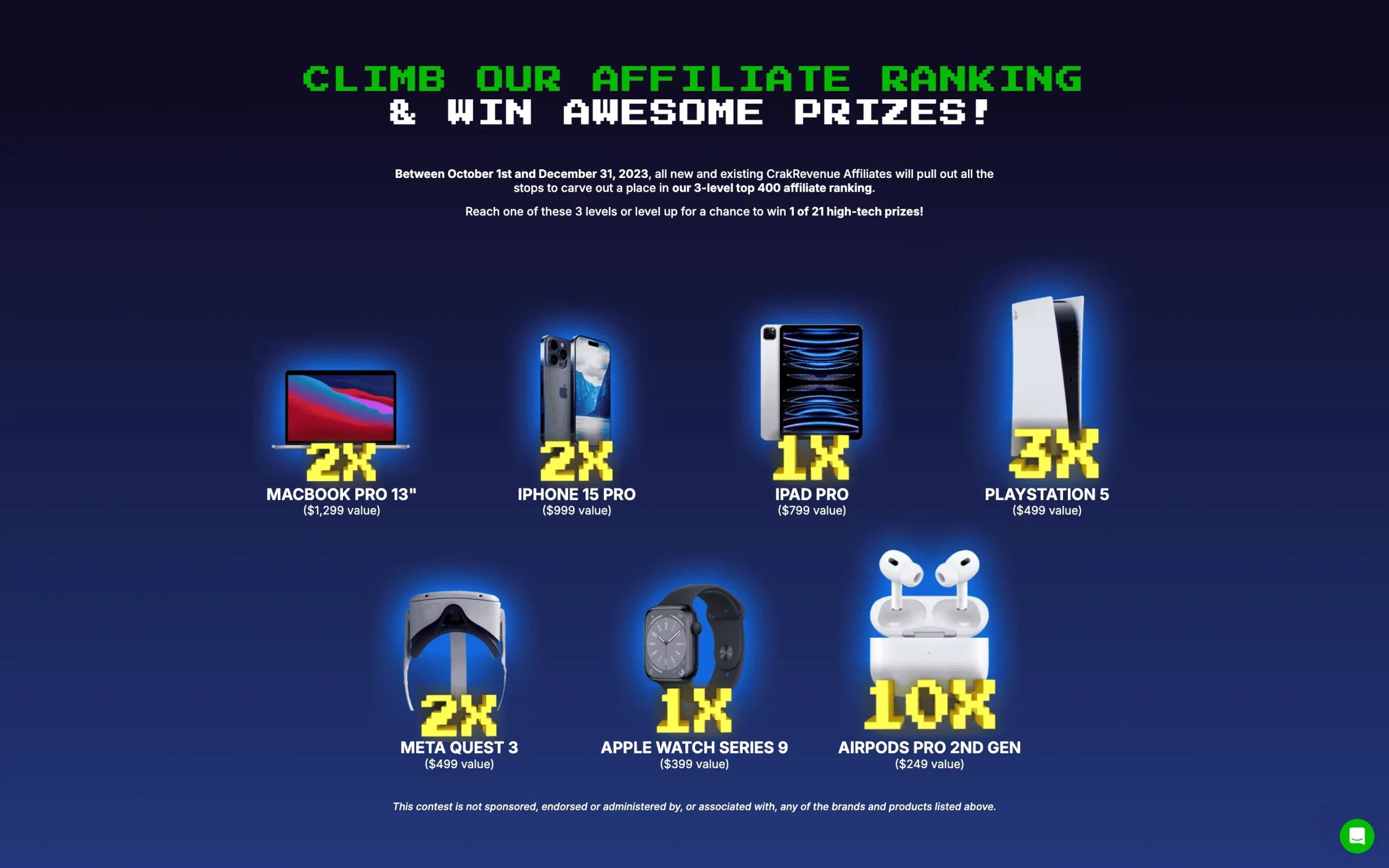
Step 4: Conduct a SWOT Analysis of Competitors’ Affiliate Programs
It seems a lot of information for you right now to absorb, isn’t it?
Gather all the information you’ve collected about each competitor’s affiliate program from previous steps. Then, organize it in a way that makes it easy to compare different aspects of their programs.
You should combine your insights into a SWOT analysis. It looks at Strengths, Weaknesses, Opportunities, and Threats. Do this for each competitor’s affiliate campaign.
Develop Your Competitive Advantage
Carrying out a thorough affiliate competitor analysis takes a lot of time and effort, so don’t let valuable information sit idle—make it work for you.
With what you’ve learned, create an action plan to help your affiliate program outsmart your rivals.
Here are some suggestions to boost your competitive edge:
Define Your Unique Selling Point (USP)
The first important thing is to reflect on your own affiliate campaign and identify your unique selling point (USP).
In simple terms, your USP is what sets your affiliate program apart from competitors in the market and makes publishers choose to work with you over others.
Define the inherent strengths of your affiliate program and your business as a whole, and then keep up the good work. Take a moment to ask yourself:
- Are your products or services superior to other brands in your niche?
- What distinguishes your company—product quality, exceptional customer service, or something else?
- Is your commission structure more competitive than those of your rivals?
- Does your brand often offer extra promotions to help affiliates attract new customers? Examples include free shipping, first-time buyer discounts, and buy-more-save-more deals.
- How committed are you to providing ongoing support and motivation to your partners throughout the collaboration?
Bonus tips: To gain an objective perspective on your USP, think about doing a survey to ask your current affiliates what they value most about working with your brand.
Refine Your Affiliate Program Benefits
Along with understanding your USP, review what you’ve learned about your competitors and compare it to your own affiliate program. Then, find ways to make yours more appealing to potential partners.
Reflect on your rivals’ strengths and think about which of these you could incorporate or improve upon in your program. At the same time, turn their weaknesses into opportunities to surpass them.
Some key areas for your refinement can include:
- Commission structure
- Cookie duration
- Affiliate incentives
- Payment methods
Adjust your commission structure
Compare your commission rate with industry standards and competitors’ offerings to see if it’s attractive enough to catch the attention of publishers. Adjust your rates if necessary to make your program more competitive.
To differentiate your offers from your rivals’, you can consider setting a tiered commission structure, as Tréskin has.
Through UpPromote, the brand established a special commission structure with four levels:
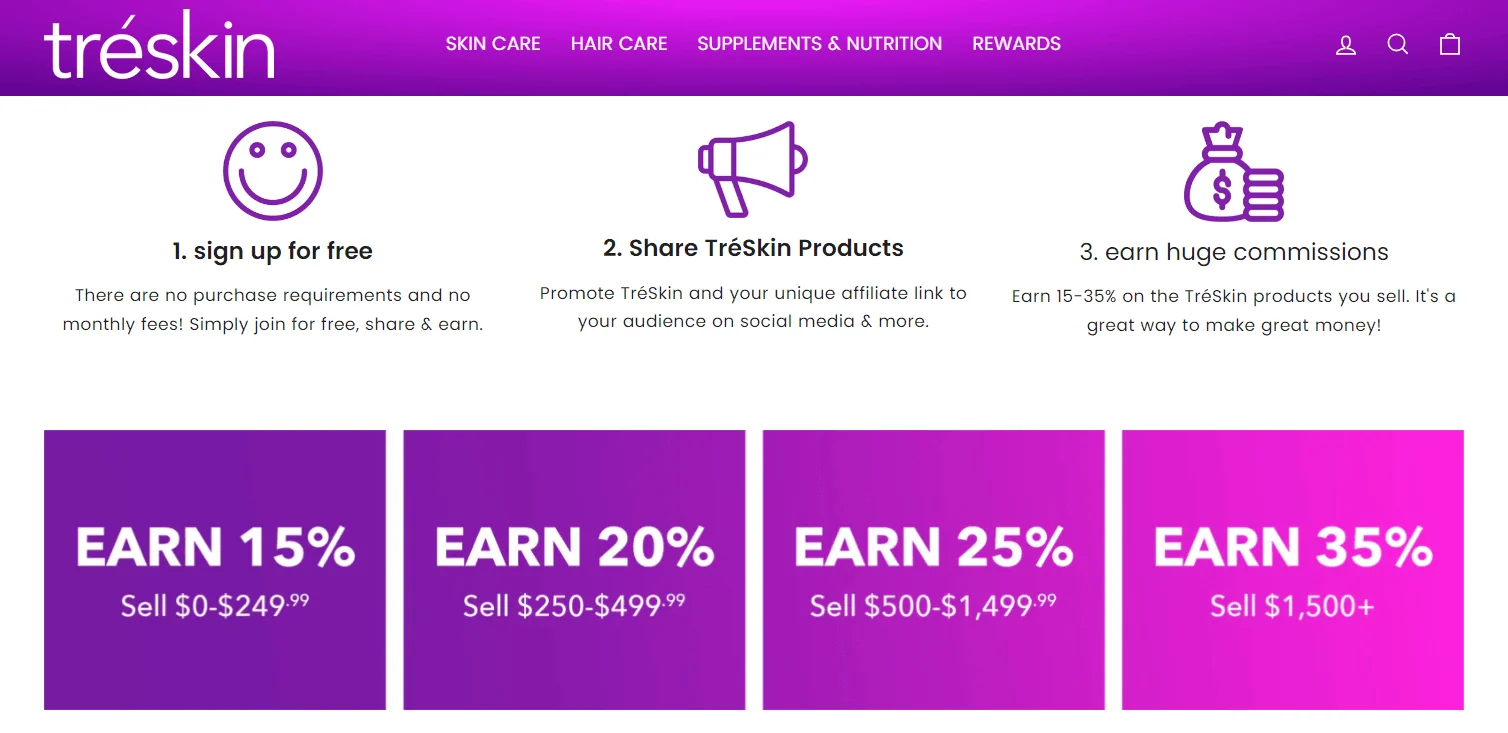 With this tempting commission setup, Tréskin attracted many high-quality beauty bloggers and influencers to join its affiliate campaign, generating $120,000 in affiliate revenue within just three months.
With this tempting commission setup, Tréskin attracted many high-quality beauty bloggers and influencers to join its affiliate campaign, generating $120,000 in affiliate revenue within just three months.
However, before making any changes to your affiliate commission structure, take a good look at your current commission rates against your margins and see if there’s any room to increase. Setting rates too high can hurt profits, while too low won’t attract affiliates. So, aim for a balance that works well for your brand.
Alter cookie duration
If feasible, make sure your cookie duration meets or is even better than most of your competitors.
By doing this, you can raise affiliates’ earning potential. So, you can have a plus in the eyes of potential affiliates, who are considering your program with others who have the same commission rates.
If you use UpPromote, our app enables you to set the cookie period for each program with just a few clicks in the Cookie settings section.
Bonus tips:
- With a good affiliate cookie duration, don’t forget to highlight it on your affiliate signup page.
- Be transparent and clearly state your cookie policy right on affiliate terms and conditions to build trust with your partners.
- Take measures to prevent affiliate fraud, including cookie stuffing, to protect the accuracy of your affiliate program.
Provide affiliates with extra bonuses
Rewarding affiliates at the right time can give recognition for their hard work and encourage them to perform better. If you haven’t incentivized your partners any time, now it’s time to change your mind.
Offering cash bonuses to top affiliates is the most attractive one, of course. And if using UpPromote, you can easily reward your top partners with our bonus feature.
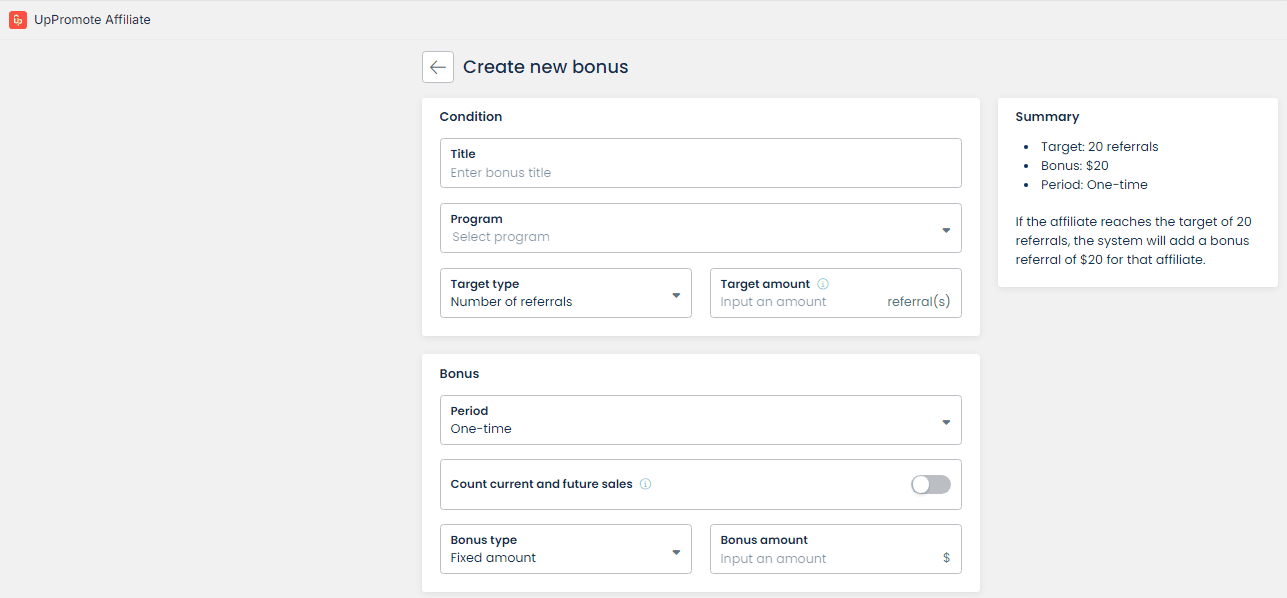
But affiliate incentives are not just cash. Depending on your affiliate marketing budget, be flexible to choose one that fits your brand, such as free gifts, exclusive discounts, or store credit.
Take Holbrook Pickleball as an example. The brand has found a great way to encourage its ambassadors through monthly sales contests.
Affiliates who reach monthly sales goals will receive fantastic rewards, such as cool product prizes. Holbrook then easily sends gift packages to top performers using UpPromote’s gift feature.

Enhance Your Affiliate Signup Experience
Making it easy and engaging for affiliates to sign up is key to attracting them to your program. The first impression they get can make a big difference in their decision to join.
There’s no doubt—your signup page is like an invitation to your program. So, do you have one? If yes, take a moment to review it: Are the main benefits of your program clearly listed so affiliates can quickly understand? And is it simple for them to fill out the form with their details?
For ideas, check out how Fiore di Perle, a brand offering luxury, handcrafted pearl-adorned accessories & jewelry, sets up its landing page to showcase program perks and encourage affiliate sign-ups.

Do you want to build a beautiful yet functional landing page that highlights your offer and motivates potential partners to complete the affiliate form?
You can discover and utilize affiliate signup form templates on UpPromote, to customize your own.
Access UpPromote’s ready-to-use templates & create a well-designed affiliate signup page—fast, easy, no coding needed.
- The Basic Template: Offer standard options for building a registration form.

- The Trendy Template: Give a modern and captivating look with dynamic sections.

- The Comfort Template: Add a touch of elegance with diverse layouts

Build Strategic Partnerships
Once you’ve figured out which affiliate types most of your competitors favor, you will get a new insight into choosing the right partners to collaborate with within your niche.
Do you want to expand your brand reach and drive more sales with affiliate marketing? Instead of relying on a single affiliate type, consider partnering with several ones.
Depending on your affiliate marketing budget, preferences, and key industry characteristics, pick the ideal affiliate marketers on your list, such as bloggers, social media influencers, review sites, cashback sites, or others.
After that, nail your outreach to connect with them effectively. Some connecting methods you should try include:
- Start email outreach
- Contact directly via social media
- Meet affiliates in person through events and conferences
Choose Affiliate Marketing Software or Affiliate Networks
Selecting the right solution to run and manage an affiliate program can significantly impact a brand’s success, not except your rivals.
Of course, you can see some brands opt for using affiliate marketing software to run their in-house affiliate campaigns, while others prefer partnering with popular affiliate networks.
So, which solution is better for you?
Let’s take a look at the pros and cons of each option for your consideration:
| Solution | Pros | Cons |
| Affiliate marketing software |
|
|
| Affiliate networks |
|
|
Actually, it’s hard to tell which is the right solution. Every brand is different, so it all depends on your specific needs, budget, and growth plans.
An affiliate network might be a good choice if you’re looking for a hands-off option and a quick way to access a large number of affiliates.
In contrast, if you want to give affiliate marketing a real go, running an in-house affiliate program is cheaper, more flexible, and offers more control.
In case you’re running an online store on Shopify and tend to create, manage, and optimize your affiliate program yourself, try UpPromote—the #1 Shopify affiliate software with a 4.9/5 rating and over 4,000 reviews.
Here’s what UpPromote provides:
- Affordable and flexible pricing options, starting with a free plan, letting you try the app with no upfront costs and scale easily at any time.
- A simple interface with built-in tooltips for seamless navigation.
- Quick and easy setup, so you can get your affiliate program live in minutes.
- 24/7 customer support to ensure a smooth setup and hassle-free management.
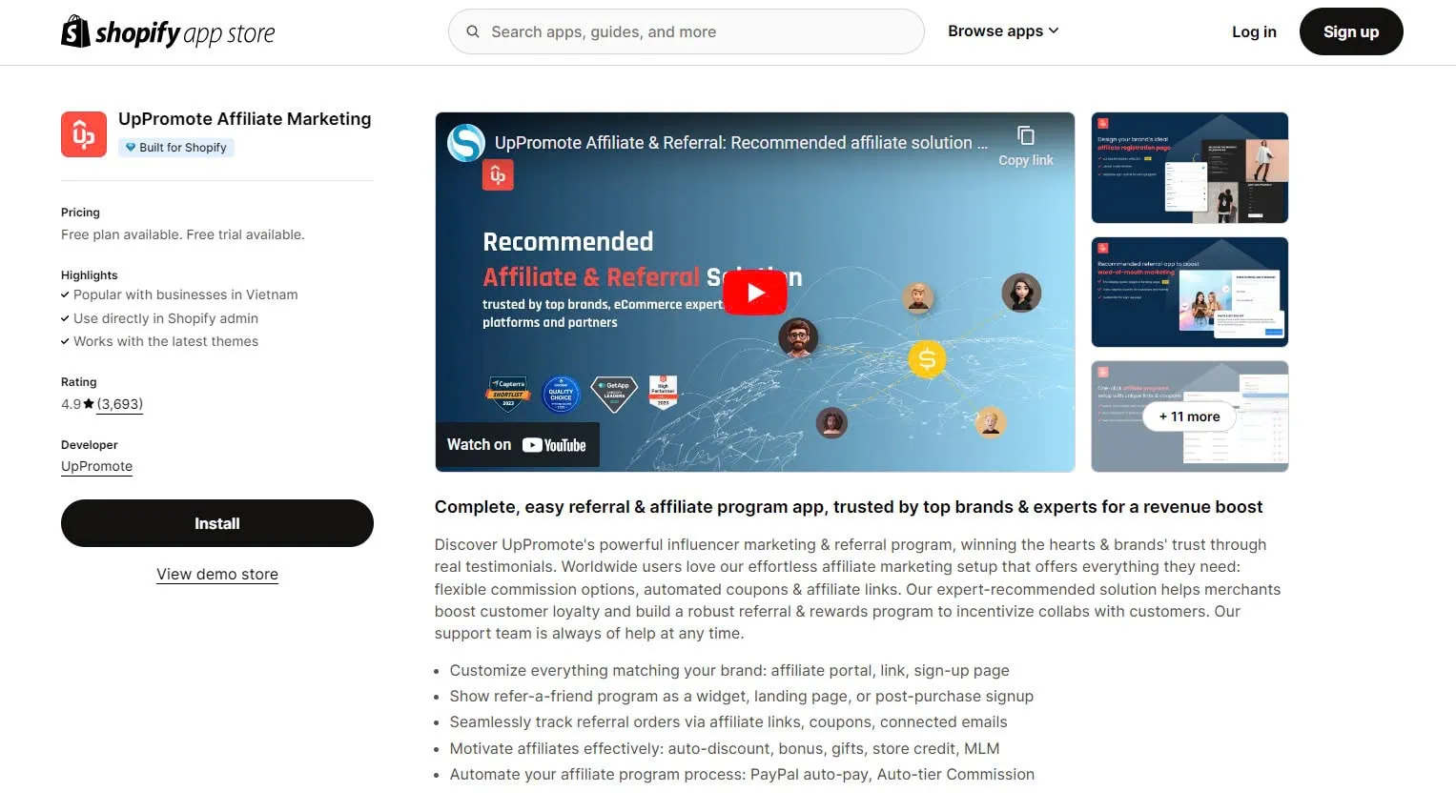
Better Your Support and Marketing Resources
One of the reasons affiliates have great working experiences with a business is to receive timely support with ready-made marketing materials because those things make them feel more confident and consistent in promoting the brand’s products or services. So, don’t ignore the importance of these factors with your own affiliate program.
Make sure you can answer any questions and provide professional support whenever your affiliates might need it. Here are a few things you can do:
- Share your program news, new products, or promotions.
- Organize webinars, record tutorials, or send emails with tips about current trends.
- Check-in if they are less active, and see if you can help.
Also, you can help your partners save time and effectively spread the word about your brand by offering them curated online marketing materials like logos, high-quality product images, videos, and pre-written content.
With UpPromote, you can easily upload media (images, videos, docs, links) for affiliate partners to use through the Media Gallery section.
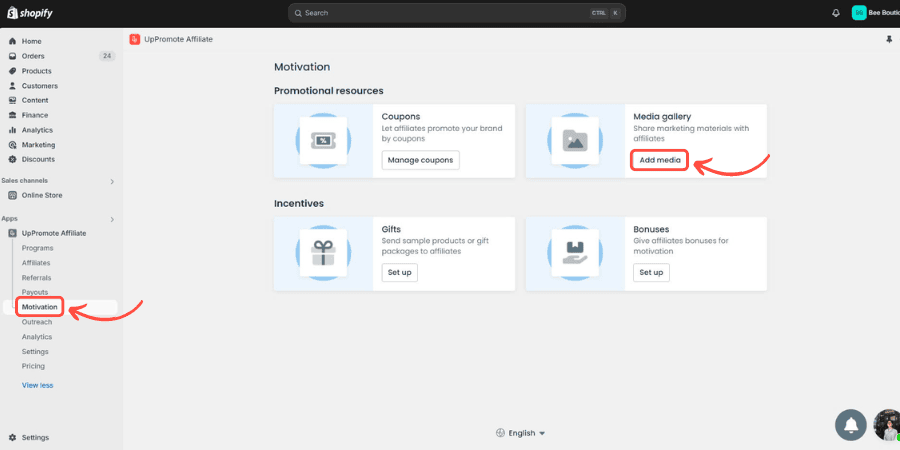
Next, you can organize your assets into categories to make it easier and faster for affiliates to find media.
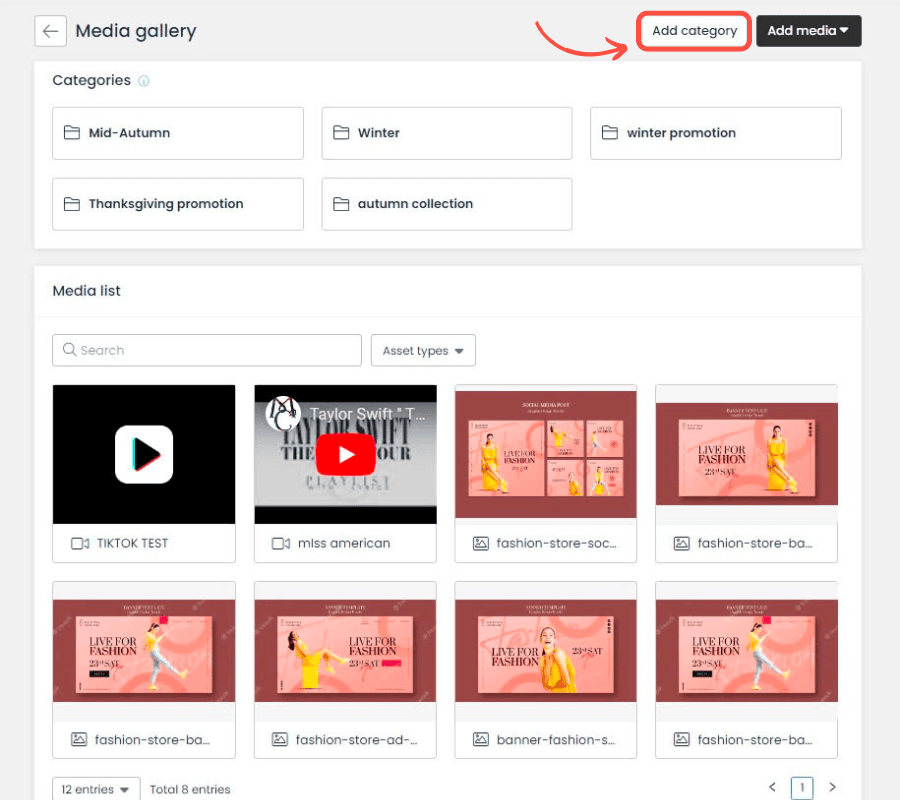 Wrapping Up
Wrapping Up
Your rivals’ affiliate programs are freely available resources for gaining insights. Analyzing them can reveal what works for your competitors and what doesn’t. You can use these insights to optimize your own affiliate campaign.
It is not easy to perform an affiliate competitor analysis. We hope our guide will assist you in approaching this task with confidence and identifying key areas for improvement that will set your company above the competition.
Keep in mind that the goal isn’t about doing precisely what others are doing but understanding the landscape so you can position your affiliate program more effectively. Filter ideas from your competitors. Adapt them to your needs. Then, craft a program that attracts high-quality affiliates and drives revenue growth.



